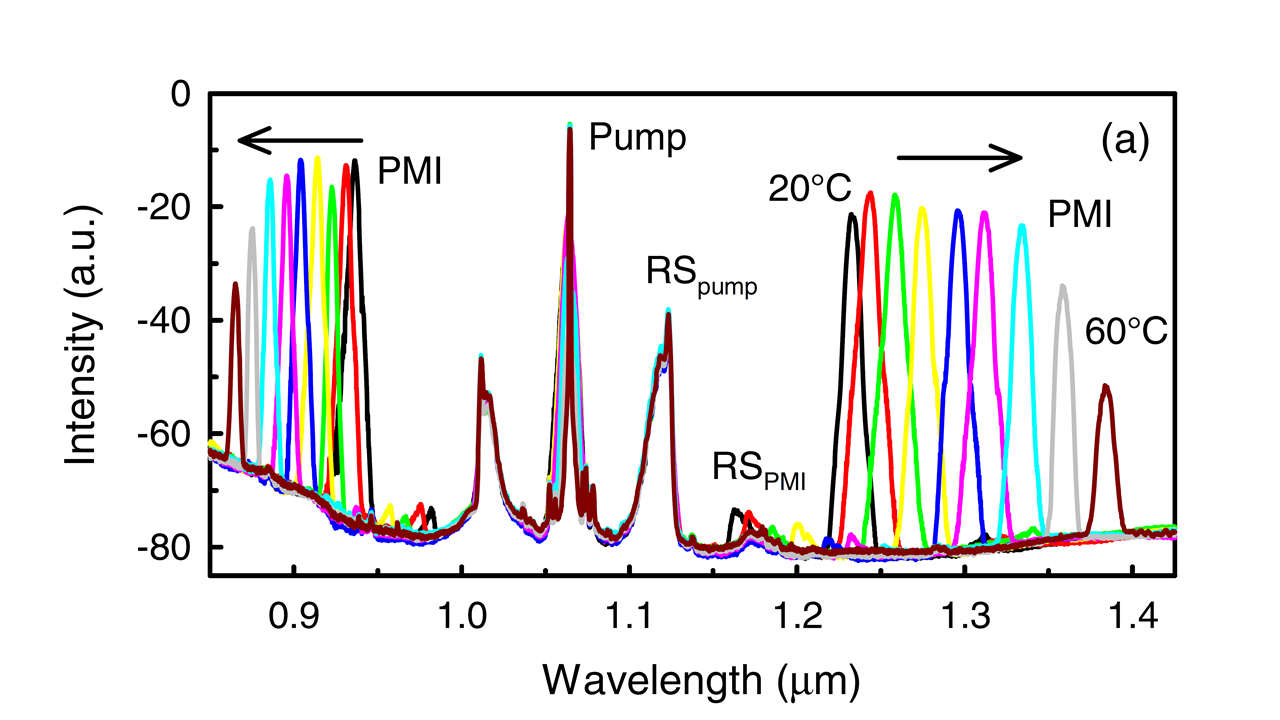Highlights
Towards the development of highly sensitive opto-mechanical sensors
The development of point sensors based on stimulated forward Brillouin scattering (SFBS) using conventional optical fibers will benefit from our recent results. On the one hand, we investigated in detail how the length of the fiber section, its diameter and the mass attached to the surface determine the signal to noise ratio and the frequency shift of the acoustic resonances. In particular, we paid attention to the operation of the sensor as an all-optical mass microbalance (Optics Express 32, 100114, 2024). On the other hand, we continue working on developing new alternatives for the implementation of efficient probe techniques (Journal of Lightwave Technology 2025).
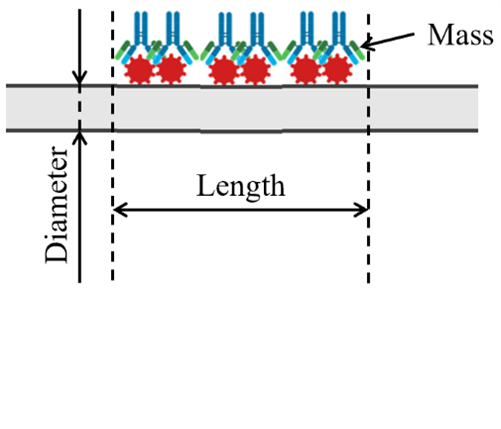
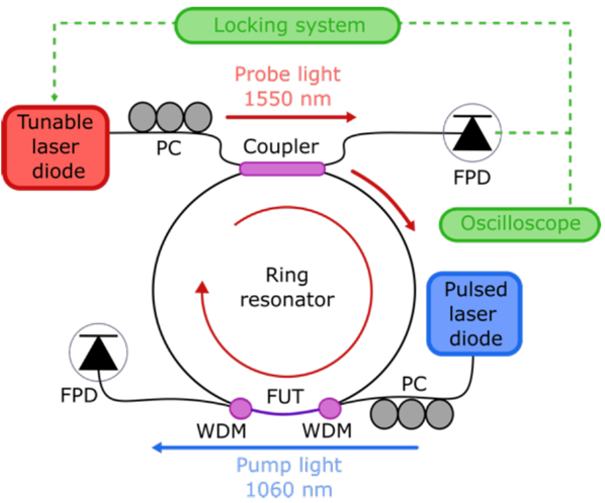
Proposal of point biosensor based on SFBS (left) and new probe technique based on a resonant fiber ring (right).
Multifrequency nonlinear Schrodinger equation
Making traditionally forbidden regimes possible, nonlinearity dispersion management is offering a growing number of promising opportunities. However, standard methods in nonlinear fiber optics were conceived for fibers which nonlinearities hardly depended on wavelength. Consequently, such approaches could now hinder the development of this research avenue. Over recent years, we released the typical nonlinearity measurement from its demand for low dispersion (see highlights below). Now we have rigorously derived a theory accounting for the multifrequency nature of the nonlinear coefficient dispersion with the computational advantages that the conventional model reached renouncing the photon number conservation. As such, this tool can be instrumental to unveil the potential that dispersive nonlinearities hold (Optics Letters 49, pp. 4713, 2024).
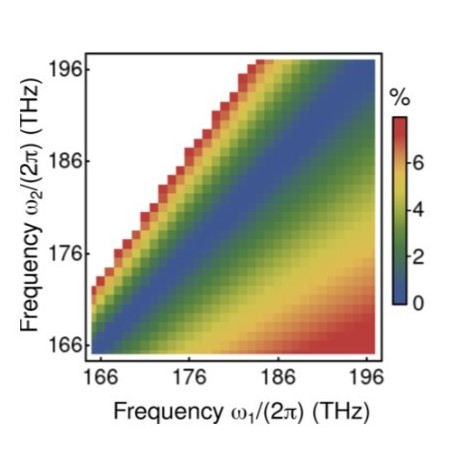
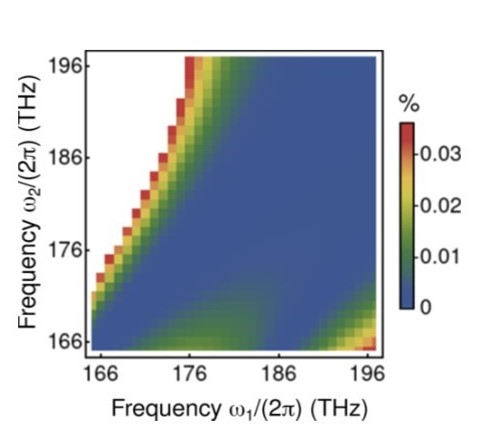
For the LP02 mode of a step-index fiber of 13 μm diameter and 0.2 numerical aperture and the processes 2ω1 → ω2 + [ω = ω1 − (ω2 − ω1)]︁, relative error of the nonlinear coefficient corresponding to (left) the conventional model and (right) our new multifrequency nonlinear Schrödinger equation.
Forward Brillouin scattering spectroscopy in optical fibers with whispering-gallery modes (WGM)
Transverse acoustic mode resonances (TAMRs) in optical fibers –which generate forward Brillouin scattering– are being promoted as the physical mechanism for new fiber-sensing concepts. The interplay between TAMRs and WGM resonances in standard optical fibers can be exploited for probing the opto-excited TAMRs using the WGM resonances. This novel probing technique provides the narrowest linewidths ever reported for the TAMRs, and demonstrates an optimum efficiency for the detection of low order TAMRs.
(Advanced Optical Materials, 2301629, 2023).

(a) Experimental setup for excitation of WGM resonances of FUT and the acoustic resonance with the PDL. TDL: tunable diode laser; PC: polarization controller; PDL: pulsed diode laser; PD: photodiode; OSC: oscilloscope; TF: tapered fiber. Inset shows the temporal profile of the pump pulses.
(b) Schematic illustration of the probing method: the transmittance of probe laser is modulated by the acoustic resonances of the FUT.
An all-in-one detector for thousands of colours
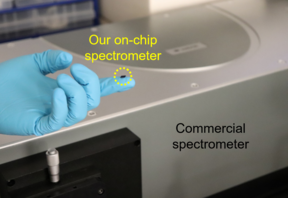
Professor Zhipei Sun, the head of the IPN-Bio research team at Aalto University, has led the development of miniaturised spectrometers with high-sensitivity, high wavelength accuracy, high spectral resolution, and broad operation bandwidth, using only a single microchip-sized detector. On-chip spectrometer are very important for future applications to offer high performance and new functions in all fields of science and industry. This research has been published in Science, 378 (6617).
Measurement of the nonlinear coefficient accounting for dispersion and loss
A balance law of the generalized nonlinear Schrödinger equation (GNLSE) allows removing fundamental limitations on the measurement accuracy of the nonlinear coefficient γ due to chromatic dispersion β2 and loss α. In our method, changes on the intensity autocorrelation at zero time delay ρ and the root-mean-square spectral width μ2 at different powers are measured, and processed by means of the propagation equation for ρ and μ2 recently derived from the GNLSE. Using this approach, we have successfully measured γ in a kilometer-long standard fiber pumped close to 2 μm, where α is more than 50 times larger than at 1.55 μm (Optics Letters 48, 493-496, 2023).
This paper has been the fifth most downloaded of its journal in its publication month.
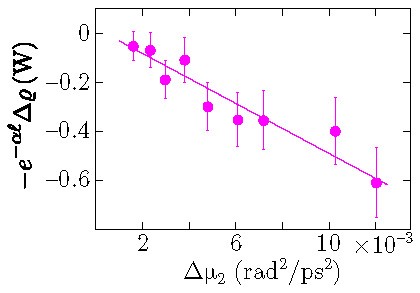
Recent advances in Forward Brillouin Scattering (FBS): Sensor applications
Point sensors based on FBS using the pump & probe technique developed in our laboratory have demonstrated to have a high potential for the development of new sensor applications. Our technique provides good signal to noise ratio (SNR) and the narrowest linewidths reported to date. FBS enables sensing the surrounding of the optical fiber in a similar way to the optical evanescent field sensors, but using the acoustic field. This review discusses the characteristics of the proposed point sensors and their potential for new sensor concepts (Sensors 23, 318, 2023). This article in Sensors is included in the list of Most Notable Articles (November 2022–January 2023).
The principle of operation of the sensor can be compared to the operation of a bell, one feeds it and it resonates with a characteristic frequency and damping that contains the sensor information. If the sensor is operated as a frequency codified sensor, then its robustness and high accuracy read-out can be assured.

Simultaneous measurement of temperature and strain using a single point sensor.
Accurate determination of Poisson’s ratio in optical fibers, and strain and
temperature measurement discrimination using Forward Brillouin Scattering (FBS)
FSBS enables a high accuracy measurement of Poisson’s ratio (ν) of optical fibers and its temperature dependence (Opt. Express 30, 42-52, 2022). Our approach is based on an all-optical pump and probe technique used for the excitation and characterization of both, radial and torsional-radial acoustic resonances of optical fibers (Opt. Lett. 45, 5331-5334, 2020). This technique enables simultaneous measurement of strain and temperature using a single point sensor (Opt. Express. 30, 14384-14392, 2022). Following this approach, the determination of Poisson’s ratio does not require the measurement of any physical length, but only frequency measurements. The dependence of fiber Poisson’s ratio with temperature is also determined experimentally.
This article in Optics Express has been highlighted as an Editor's Pick.
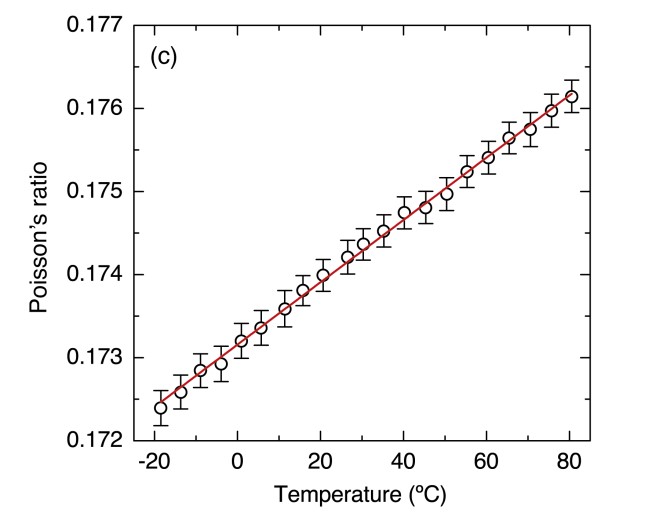

Broadband tuning of polarization modulation (PMI) in photonic crystal fibers (PCF)
Wideband tuning of strong bands generated through polarization modulation instability (PMI) in photonic crystal fibers (PCF) is achieved via thermal tuning of fiber’s chromatic dispersion and birefringence, using PCFs infiltrated with ethanol and pumped at 1064 nm (Optics Letters 45, 4891-4894, 2020). In a previous article, we demonstrated tunable PMI in all-normal dispersion (AND-i) photonic crystal fibers, in which scalar four wave mixing (FWM) was forbidden (IEEE Photonics Journal 11, art. 7104108, 2019).
